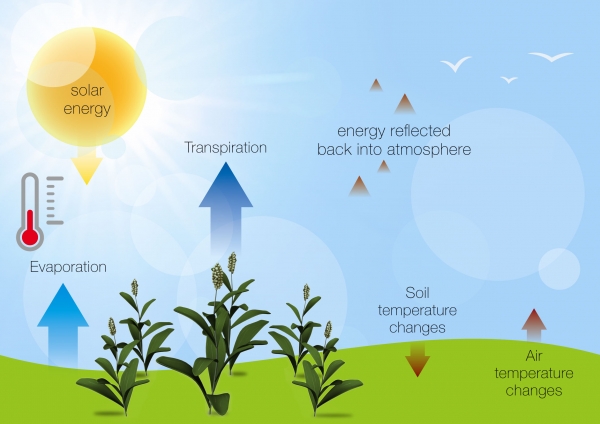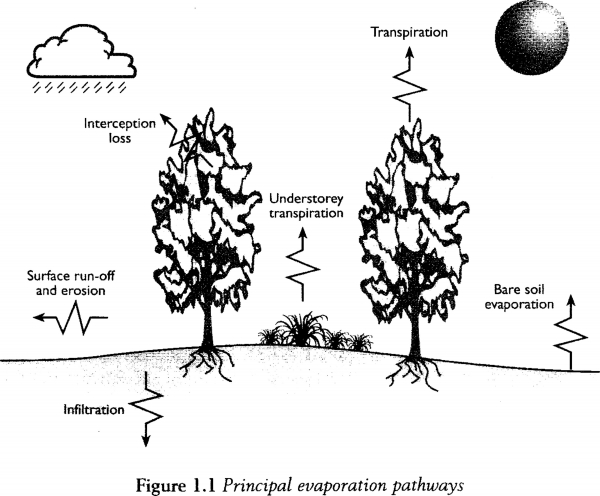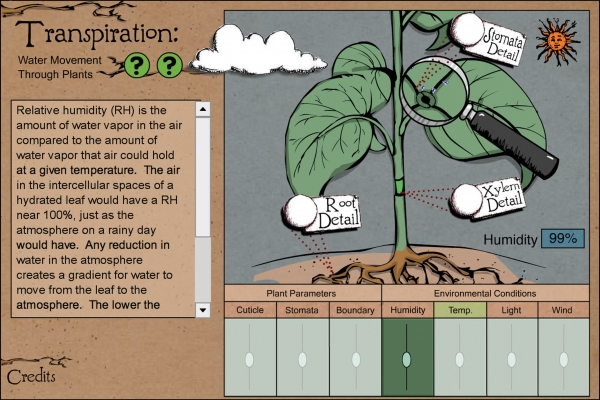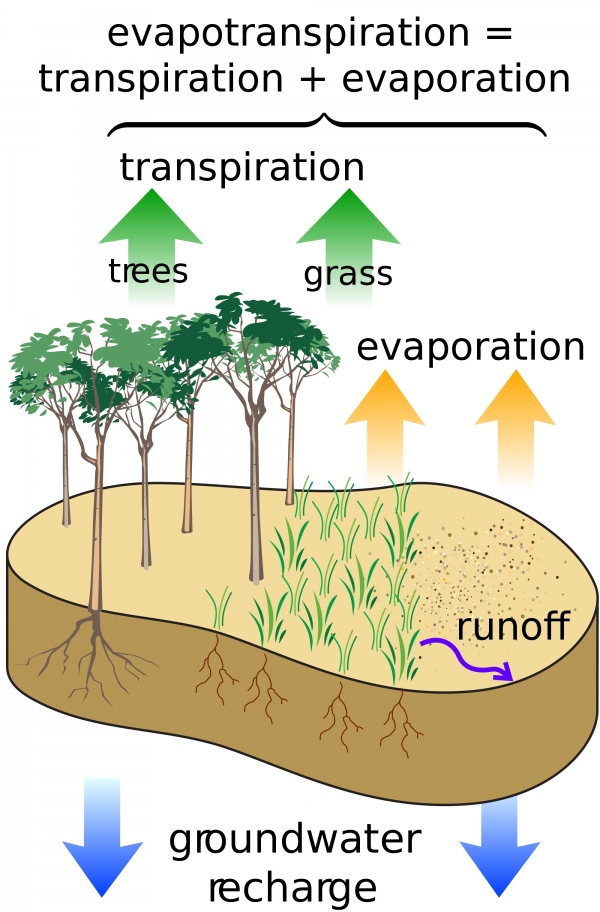EVAPOTRNSPIRATION
Definition: -
Evapotranspiration (ET) is a process of evaporation of eater from all surfaces and transpiration from all vegetations. Thus the ET has two components
1) Evaporation
2) Transpiration.
Both soil plants acts as the atterned path through which water flows on its way to the surface from which it finally diffuses into the air. ET from a vegetated surface is a complex phenomenon.
ET is an Agro meteorological factor: -
ET is an agro meteorological process/factor because three atmospheric factors are responsible and essential for the process to take place.
The essential atmospheric factors required for the process are
1) Radiation: - Availability of energy at the evaporating surface (energy)
2) Wind: - Availability of wind to transfer water vapour away from the evaporating surface.
3) Water: - Availability of water at the evaporating surface.
The sources of above three factors are radiation: -
Radiation:
1) From the sun, sky and clouds.
2) Sensible heat transfer from adjacent air and soil.
Wind:
1) From the thermal heating of surface, vertical gradient of humidity and turbulent mixing in the lower layers.
Water:
Precipitation, irrigation and soil moisture storage.
Actual evaporation (AET): -
The rate of ET from a partially wet surface or in actual condition is known as AET. The ET taking place at actual field condition is known AET.
It is generally affected by the nature of the ground and the characteristics of the vegetation. Hence AET is the function of soil, plant and weather conditions.
AET = f (soil, plant, weather)
It can be measured by
1) Gravimetric method
2) Lysimeters.
Potential evaporation: - (PET)
When water supply is unlimited to the system where ET takes place, a different concept is used, which is known as PET.
Definition: PET is defined as the water loss from the surface that occurs if there is no deficiency of in the soil for the use of vegetation at any time of its growth. It is only influenced by meteorological parameters or it is the function of weather.
PET = f (weather parameters)
Definition of PET by Thornthwaite (1948)
American climatologist Thornthwaite has put forth the concept of PET for the first time in 1948. According to him the PET is defined as “the amount of water lost by evaporation and transpiration from a soil surface covered with vegetation is governed by climate factors and is independent of species who moisture supply is not limiting.
Definition of PET by Penman (1948)
According to H.L. Penman (1948), the England climatologist, the term is defined as “ the amount of water transpired in unit time by a short green grass completely shading the ground of uniform height and never short of water.
It is a physical phenomenon controlled mostly by meteorological parameters and is independent of species.
Factors affecting PET: -
The important meteorological factors influencing PET are
1. Solar radiation
2. Temperature
3. Relative humidity
4. Wind
5. Sunshine
6. Soil moisture.
Estimation of AET: -
Computation of AET is complicated in view of being it dependent on fluctuating plant physiological, soil physical and atmospheric parameters. Hence, the concept of PET was evolved by Thronthwaite and Penman to estimate it by using PET and crop co-efficient.
Method of determining AET: -
(A) Method of measurement: -
I. By weighing type Lysimeters.
II. By Gravimetric method.
(B) Estimation of AET: -
I. Climatological water balance approach by Thornthwaite using appropriate pattern of soil moisture condition.
II. Estimating PET by Penman method by assuming an albedovalue for the crop.
III. Pan evaporation method by using a crop factor for the crop.
ESTIMATION OF PET – METEOROLOGICAL PARAMETERS: -
(1) Thornthwaite method: - (1948)
(2) Penman method: -
Use of ET data: -
1) In planning farm irrigation and water management studies.
2) In estimating the acreage of crops.
3) Scheduling irrigation i.e. when, how much and how to irrigate.
4) To calculate water requirement of crops.
WATER BALANCE
Field water balance is a convenient way to evaluate the water cycle as a whole accounting for all the water entering (input), leaving(output) and remaining in the soil ( soil storage) during any period of time. It is immediately connected with
1) Energy balance
2) Soil moisture status.
The total water balance is given as
P+I = R+D+ET+S
Where, P = precipitation D = drainage
I = irrigation ET = evapotranspiration
R = runoff S = water status
In water balance it is to measure “input” components but difficult to measure “output” terms.
For long period such as a month or a season the water balance may be given as:
P+I = ET+D
For short periods such as a day or a week a change in soil temperature content can be relatively large and should be measured. This is important for agriculture point of view.
Definition:
The water balance means the actual short-period accounting of the moisture conditions at a given place and time. The moisture condition involves supply, storage and loss of water.
Its utility in Agriculture: -
• It provides time to time variations in soil moisture for the purpose of ET from the agricultural fields.
• It provides an idea when to apply irrigation and on crop scheduling problems.
Measurements of water balance components:
1) Precipitation: - ordinary rain gauge and self recording rain gauge.
2) Run-off : - it is difficult to measure directly. It is estimated by using the basic water balance equation and by estimating evaporation and rain gauge.
3) Drainage : - it is difficult to measure but can be estimated with hydraulic conductivity and soil moisture profile. It is considered to be negligible.
4) Water storage: - change in water storage can be measured by Lysimeters.
Soil water sensing equipments like gypsum blocks, tensiometers and neutron probes are used to measure as
I. Evaporimeters USWB pan E.
II. Empirical formula or meteorological methods.
Use of WB components in Agriculture: -
WS = it gives the amount of water that can be used at another time and place.
∆St = indicates the moisture available in the soil.
AET = moisture used by the crop.
WD = water deficit i.e. water required by crops for meeting the demands.

Energy balance
Evaporation pathways
Transpiration
Evapotranspiration

